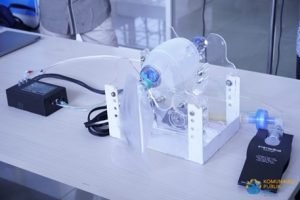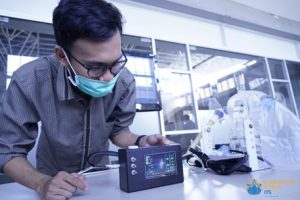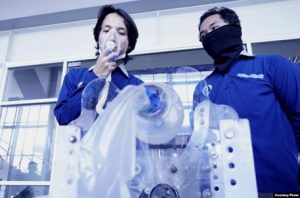COVID-19 Emergence in Indonesia, Students and Lecturers of Engineering Physics ITS Collaborated to Develop a Cheap Ventilator
News

Figure 1: Emergency Ventilator by The Collaboration of Students and Lecturers—0 of Engineering Physiscs ITS (https://www.its.ac.id/news/berita/)
In the midst of the COVID-19 pandemic, Engineering Physics ITS collaboration of students and lecturers created an emergency ventilator or a low-cost and simple ventilator robot to help medical personnel handle the COVID-19 patients. The collaboration was formed on Tuesday, March 24th 2020 by Dr. Rer. Nat. Ir. Aulia M. T. N., MSc and Iwan Cony S., S.T., M. T on the direction of A. M. Hatta, S.T., MSi., PhD as part of the LPPM (Research Institute and Community Service).
Making an emergency ventilator aims to help COVID-19 patients who have respiratory distress. It is because of the consideration that the ventilator price reached to Rp 800 million so is difficult to fulfill the needs of many ventilators in a short time especially in developing countries, such as Indonesia. Moreover, the number of patients is increasing every day, so it needs a lot of ventilators. This emergency ventilator has an open source design base and a mechanical system that adopts from MIT. However, the monitoring and electronic system was developed entirely by Engineering Physics ITS collaboration of students and and lecturers. The ventilator also features Respiration Rate, Inspiration/Expiration Ratio, Tidal Volume, PEEP (Positive End-Expiratory Pressure), and PIP (Peak Inspiration Pressure) settings, as well as a compression system in this emergency ventilator that is done automatically. In addition, Engineering Physics ITS collaboration of students and and lecturers also sought to added features of LCD touch screen, as well as operated by mobile phones to be more user friendly. The ventilator is also equipped with a filter that capable to prevent the transmission of the virus through the air in the ventilator.

Figure 2: The lecturer who is the member of collaboration team operated the Emergency Ventilator (https://www.its.ac.id/news/berita/)
One of the team members, Iwan Cony S., S.T., M., said that the making of emergency ventilator began on March 27th 2020, until April 1st-2nd 2020 began to be seen the ventilator’s construction. The emergency ventilator is the first prototype that was successfully operated from 3 prototypes that have been made. However, this emergency ventilator is still in the process of feasibility trial. As well as a test-performance tool to be used within 2×24 hours without human intervention. The process of feasibility trial is done by the team, as well as cooperation with the Health Facility Security Center (BPFK), Airlangga University Hospital (RSUA), and RSUD Dr. Soetomo. “The plan ahead after this tool get a distributor permit, then this ventilator can be produced,” said Mr. Iwan.

Figure 3: Students who are the members of collaboration team tried to use the ventilator (https://www.voaindonesia.com/a/its-ciptakan-ventilator-biaya-murah-bantu-penanganan-corona/5363606.html )
The raw materials which used to make this ventilator is quite accessible because some of the components which used are widespread in the market, such as acrylic print laser service, ambu bag (Bag Valve Mask/BVM) that can be purchased from medical equipment stores. The difficulty experienced in the process of making this tool is to find a suitable motor as the mobilizer because the torque used is large enough.
Hafid, the member of the team explained that in the process of making the emergency ventilator using some software such as, 3D Design Software namely Solidworks and Autodesk Fusion used to design the acrylic pieces and scaffolding. In addition, Autodesk Eagle Software is also used to design PCB. Then for the development of electronic systems is using the application of basic electronic sciences. Then the controller used is the Arduino. “In the construction of this ventilator also needed skills in computer programming and development,” said Hafid.
This complex ventilator process provides a distinctive impression for lecturers and students who are the members of the team. Plus, the process of making the ventilator is done together without the division of tasks. The student team members consist of Hafid, Fafa, Yaseh, Linggar, Sapto, Yogi, Dipra, and Pur claimed to have a lot of new experiences such as understanding the ventilator’s work system, ventilator usability, and understanding the parameters used in good ventilator manufacturing.
Latest News
-
ITS’s Achievement in QS
The following is the ranking of ITS in QS Post Views: 1,489
-
Standard Operating Procedure Limited Face-to-face Lectures ITS 2022
Well this time, there is important information for all campus friends. On February 7, 2022, a Limited Face-to-face Lecture
-
Preparation for the Implementation of Lectures in Spring Semester 2022
Here we convey information regarding the preparation for the lectures implementation of Spring Semester 2022 at the Engineering Physics





